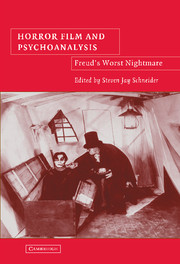Book contents
- Frontmatter
- Contents
- Acknowledgments
- Foreword: “What Lies Beneath?”
- Introduction: “Psychoanalysis in/and/of the Horror Film”
- PART ONE THE QUESTION OF HORROR-PLEASURE
- PART TWO THEORIZING THE UNCANNY
- 5 Explaining the Uncanny in The Double Life of Véronique
- 6 Manifestations of the Literary Double in Modern Horror Cinema
- 7 Heimlich Maneuvres: On a Certain Tendency of Horror and Speculative Cinema
- 8 “It was a dark and stormy night…”: Horror Films and the Problem of Irony
- PART THREE REPRESENTING PSYCHOANALYSIS
- PART FOUR NEW DIRECTIONS
- Afterword: Psychoanalysis and the Horror Film
- About the Contributors
- Bibliography
- Index
6 - Manifestations of the Literary Double in Modern Horror Cinema
Published online by Cambridge University Press: 14 July 2009
- Frontmatter
- Contents
- Acknowledgments
- Foreword: “What Lies Beneath?”
- Introduction: “Psychoanalysis in/and/of the Horror Film”
- PART ONE THE QUESTION OF HORROR-PLEASURE
- PART TWO THEORIZING THE UNCANNY
- 5 Explaining the Uncanny in The Double Life of Véronique
- 6 Manifestations of the Literary Double in Modern Horror Cinema
- 7 Heimlich Maneuvres: On a Certain Tendency of Horror and Speculative Cinema
- 8 “It was a dark and stormy night…”: Horror Films and the Problem of Irony
- PART THREE REPRESENTING PSYCHOANALYSIS
- PART FOUR NEW DIRECTIONS
- Afterword: Psychoanalysis and the Horror Film
- About the Contributors
- Bibliography
- Index
Summary
It is … the relationship between normality and the Monster that constitutes the essential subject of the horror film…. The relationship has one privileged form: the figure of the doppelgänger, alter-ego, or double, a figure that has recurred constantly in western culture, especially during the past hundred years…. The doppelgänger motif reveals the Monster as normality's shadow.
– Robin WoodAccording to Laurence Rickels, author of The Vampire Lectures, and a master of the catchy academic turn of phrase (yes, such a thing does exist),
Literature, which is where the phantasm of the double used to be at home … in the eighteenth and nineteenth centuries, during the opening era of the uncanny, suddenly released the double and no longer featured it. At the same time film and psychoanalysis were the two new institutions that began attending to the double feature.
(90)Of course, neither film nor psychoanalysis attended to this double feature in isolation from one another. Otto Rank, in a 1914 paper, claimed that “the uniqueness of cinematography in visibly portraying psychological events calls our attention, with exaggerated clarity, to the fact that the interesting and meaningful problems of man's relation to himself – and the fateful disturbance of this relation – finds … imaginative representation” (7). And after reading Rank's piece, Freud himself makes mention of Paul Wegener's German doppelgänger film, The Student of Prague (1913), in his seminal 1919 essay, “The ‘Uncanny’.”
- Type
- Chapter
- Information
- Horror Film and PsychoanalysisFreud's Worst Nightmare, pp. 106 - 121Publisher: Cambridge University PressPrint publication year: 2004
- 3
- Cited by

